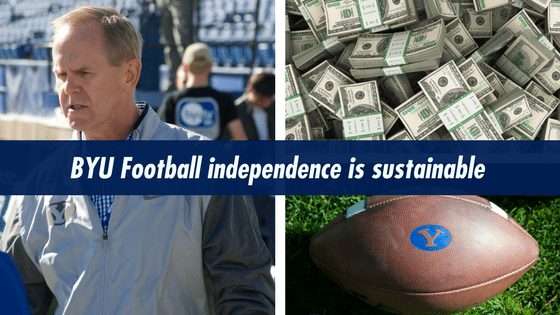
By: Ryan Teeples (@SportsGuyRyan)
ESPN 960 Contributor
BYU fans want improvement, and rightfully so. They want success. They want the Cougars to win 10 football games a year. They want their basketball team to be a staple in the NCAA tournament. And a growing segment of the fanbase (and some media members) want desperately for BYU to change its conference affiliation, even encouraging a move back to the Mountain West.
“Independence is unsustainable”
This seems to be the rallying cry for the segment of fans and journalists who want BYU to head back to a conference at all costs. If a so-called Power Five conference (P5) offer comes, there’s no doubt that’s a no-brainer decision for the Cougs. And even a non-power conference (G5) arrangement with basketball is worthy of consideration if football isn’t part of the deal.
But many (including some notable alum and media with limited business acumen) argue football independence isn’t sustainable and joining a G5 conference for all sports is better than the status quo.
That’s not only enormously false, but it’s more likely the opposite is true. The evidence is in the numbers, which so very, very few fans and media members seem to be interested in consulting before formulating an opinion. And it is really not even close.
The Money
BYU generates around $67 million a year in revenue. Considering it gets tens of millions less than Big Ten and SEC teams in TV revenue, that’s not too bad. It’s very good, in fact. It puts BYU at about 55th in total revenue, compared to the bottom half of Pac-12 schools and higher than any G5 school.
BYU actually produces as much or more revenue than a good portion of P5 schools in all categories outside of TV revenue. BYU is still on a 2010 contract which was negotiated before the huge inflation in TV value for college sports. Though not publicly known, BYU’s 2010 independent TV contract with ESPN is estimated to be somewhere between $6-10 million annually, which is on par with what ACC teams got around the same time.
Pac-12 conference teams, which earned the lowest TV payouts among P5 conferences, got about $27 million last year, or about $17 million more than BYU. The Big Ten pays over $50 million. So even among P5s, there’s a major disparity.
But outside that wide gap in TV earnings, BYU is pretty much on par with P5 schools in all other revenue activities.
But the G5 are not. Not even close, actually.
A lot of help from the taxpayers
Below is a table showing revenues for all public Pac-12, MWC and AAC schools, sorted by total revenue generated.
When you look at the annual revenue numbers on the face, it appears that while there is a gap, the difference between lower P5 and upper G5s isn’t that large. Washington State generates $58 million while Central Florida generates $59 million in “revenue.” However, these numbers are misleading.
When you look deeper, an enormous disparity presents itself. The G5 schools are very heavily subsidized by tax dollars (Column E). The top budgeted athletic departments in the G5 are mostly AAC schools: UCONN, Central Florida, Cincinnati, San Diego State, and Houston. All of them—repeat ALL OF THEM—have over 40% of their athletics budget subsidized by their state government.
Pennies competing with Benjamins
When you subtract the taxpayer-subsidized portion of athletic department revenues (Column E), the numbers are stark for the G5. Not a single school outside the five Power Conferences generates more than 40 million dollars a year on their own—except BYU.
Even in the best cases, the G5 schools can barely generate HALF the revenue necessary to sustain operations (Boise State being the lone exception).
An average P5 school generates $105 million in revenue without subsidies.
The average G5 school with football: $13 million.
The G5 school with the most revenue without subsidy is UCONN at $43 million, still more than 10 million below BYU. After that? Central Florida at $35 million. Houston, near the top of the G5 list, generates HALF BYU’s revenue at $26 million.
What is “sustainable?”
Let’s back up to the “independence is unsustainable” argument the ill-informed love to toss around regarding BYU. These are the facts:
- BYU generates significantly more revenue than any other G5 school, nearly five times the G5 average
- BYU generates a profit in athletics, one of just a handful of such schools in all of college athletics
- G5 school athletics departments will fold without tens of millions of dollars per school from state taxpayers
- Cost of education has doubled plus 50% since 1990 and the value of college education is declining annually
- The Chronicle of Higher Education, the leading voice in such matters calls this subsidization “An epidemic”
- The Foundation for Economic Education in a recent report indicated the model is breaking, stating “If students and their parents knew how much they were spending for sports, would they stand for it? Many probably wouldn’t.”
The state of G5 athletics is a case-study in financial instability.
Is there a middle ground? What about the new TV contract?
Many BYU fans clamoring for BYU to go back to the Mountain West or to the AAC feel Tom Holmoe could negotiate a preferred deal for TV revenue like Boise State did with the MWC. Unfortunately, it is still not close to enough for football.
BSU got $2.9 million in TV money last year while other conference members barely eclipsed $1 million. AAC schools also only get about $2 million and are expected to be hurt by the loss of members in place when the current deal was done and the addition of unattractive TV schools like Tulane and Temple.
Many worry about BYU’s TV contract will likewise be less when it is renegotiated next year. By all measures that are not a worry. ESPN didn’t hesitate to execute its one-year extension offer on the current deal. If ESPN thought the next contract was going to be more advantageous to them, there’s no way in Laramie they’d have extended the current one.
Have college sports TV deals been overinflated? Maybe at the absurd peaks in 2016. But maybe not. BYU’s current TV deal was negotiated at the VERY START of the sharp rise in college TV value. And it isn’t predicated on adding cable subs in a geographic area like other conferences. Barring some economic collapse, BYU will get another bump in its 2019 TV deal, possibly triple, even considering softening in the market.
In the status quo, the TV money is significantly better and the flexibility to join a P5 conference, should the opportunity arise, is open. So how is Independence not sustainable?
Keeping the right company
Fans will argue that not being in a conference or having the chance to play for a New Year’s bowl like G5 schools do is detrimental to BYU long-term. Maybe a little. But does that mean unsustainable?
Unsustainable would be a program that can’t afford quality coaches. One that can’t get good facilities. One that doesn’t have a stadium and fanbase that can generate ticket sale revenue. One that can’t offer recruits a decent cost of attendance stipend. One that is a single state legislature session or tax revenue shortfall away from collapse. One that is G5.
All that aside, would you build a strategic alliance with businesses who are reliant on subsidies to fund a majority of their operations? Of course not. Why then would BYU align itself in a similar manner?
And how long will American taxpayers dole out hundreds of thousands for their kids to attend a state school while watching those same school athletic departments get tens of millions for tier 2 sports?
During a commission meeting late last year Tulane’s president predicted cataclysmic changes for G5 schools. There are already rumblings that a split between P5 FBS and G5 FBS is inevitable. The Group of Five schools is drifting toward an iceberg.
Staying the Independent course is the ONLY option
BYU looks far more like a P5 school than a G5. The numbers show it has great sustainability in the current model and can expect that security to grow after the next TV deal. Why then board a sinking ship with passengers who had to borrow heavily to get aboard on the slim chance it might stop at a cool port before it goes down?
Remain on shore waiting for another ship or a change in the fleet. That right now is the ONLY “sustainable” course for BYU.
Ryan Teeples is a contributor to ESPN 960 Sports and a Sports Business contributor at the Deseret News. Teeples is a marketer and entrepreneur. You can follow him on Twitter at @SportsGuyRyan.








